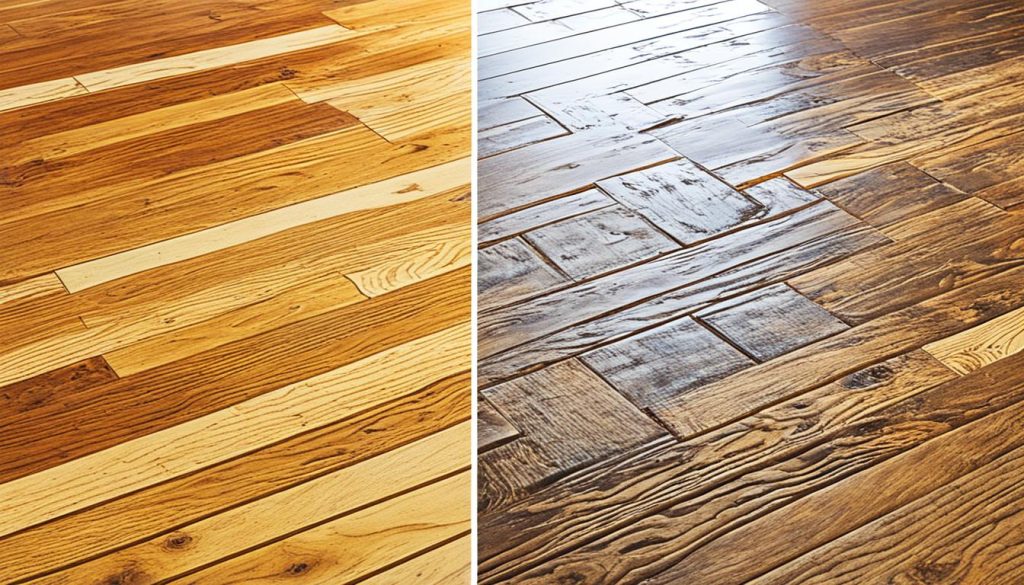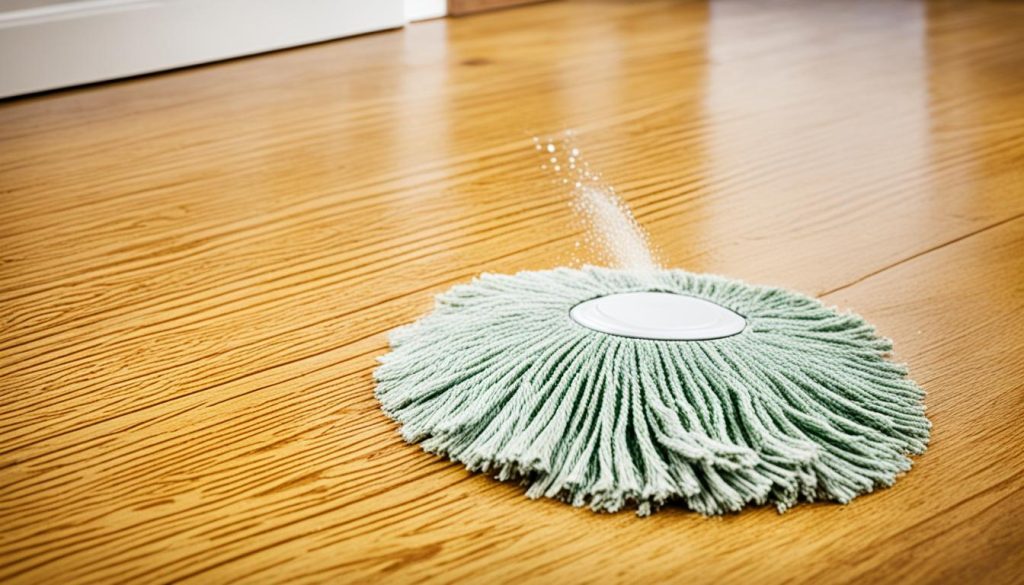Did you know that cat urine contains ammonia, which can cause respiratory issues and allergies in humans? If you’re dealing with cat urine stains on your precious wood floors or furniture, it’s not just about removing the stains; it’s also crucial to eliminate the associated odor. In this guide, I will provide you with effective methods to get rid of cat pee smell from wood surfaces.
Key Takeaways:
- Removing cat urine odor from wood is as important as removing the stains.
- Cat urine contains ammonia, which can be harmful to human health.
- Follow these effective methods to eliminate the lingering smell from your wood surfaces.
- Enzymatic cleaners, vinegar, baking soda, dish detergent, club soda, and sanding can all be effective solutions.
- Proper preparation and ventilation are essential before starting the cleaning process.
Preparing the Area for Cleaning
Before tackling those stubborn cat urine stains on your wood floors, it’s essential to properly prepare the area for cleaning. By following these steps, you’ll maximize your chances of success in cleaning wood floors from pet urine and eliminating cat urine stains from wood.
Ventilation is Key
To begin, open windows or use fans to improve airflow in the room. This will help remove any lingering odor and floating urine particles from the air. Adequate ventilation is crucial for a thorough clean and ensuring that the odor doesn’t stick around.
Blot Up Wet Urine
It’s important to act quickly and blot up any wet urine from the wood surface using paper towels or a clean cloth. This will prevent the liquid from seeping deeper into the wood, making it easier to remove the stain and eliminate the smell. Remember to blot gently to avoid spreading the urine further.
Creating a clean and odor-free environment is the first step towards effectively removing cat urine stains from wood. By following these preparations, you’ll be ready to tackle the next steps in the cleaning process.
Using Enzymatic Cleaners
When it comes to effectively eliminating cat urine odors from hardwood floors, enzymatic cleaners are the best option available. These specialized cleaners are formulated to break down the urine compounds and completely neutralize the odor. By targeting the source of the odor, enzymatic cleaners ensure that your wood floors are left clean and odor-free.
The best way to clean cat pee from hardwood floors is to follow these simple steps:
- Identify the stained area on your hardwood floor.
- Choose a high-quality pet stain remover for wood that contains enzymes. These products can be found at your local pet store or online.
- Ensure the stained area is dry and free from any debris.
- Spray the enzymatic cleaner directly onto the stain. Make sure to cover the entire area.
- Allow the cleaner to sit for at least 15 minutes. This will give the enzymes enough time to break down the urine compounds and eliminate the odor.
- Gently blot the area with a clean cloth or paper towel to remove any excess cleaner.
- Rinse the area with water and pat it dry.
Using enzymatic cleaners is a safe and effective way to remove cat urine stains and odors from hardwood floors. These cleaners not only eliminate the odor but also prevent your furry friends from remarking the same area. Keep in mind that it may be necessary to repeat the process for particularly stubborn stains or strong odors.
For a visual demonstration of how to use enzymatic cleaners on hardwood floors, refer to the image below:

| Benefits of Using Enzymatic Cleaners | Drawbacks of Using Enzymatic Cleaners |
|---|---|
| Effectively neutralizes cat urine odors | May be more expensive compared to other cleaning methods |
| Breaks down urine compounds for thorough stain removal | Requires sufficient drying time for optimal results |
| Prevents cats from remarking the same area | Some enzymatic cleaners may leave a residue if not rinsed properly |
Using Vinegar and Baking Soda
If you’re looking for a natural solution to remove cat urine odor from wood, vinegar and baking soda are a great option. These pantry staples can effectively neutralize and eliminate the unpleasant smell.
To begin, sprinkle a generous amount of baking soda over the stained area. Allow the baking soda to sit for about ten minutes. This will help absorb and neutralize the odor.
Next, pour vinegar directly onto the baking soda. You’ll start to see the mixture bubble and fizz. This reaction helps to break down and remove the odor-causing compounds in the wood.
If you prefer a spray solution, mix equal parts vinegar and water in a spray bottle. Spray the mixture onto the stain and let it sit for a few minutes before wiping it clean.
This simple yet effective method using vinegar and baking soda can help you eliminate cat urine odor from your wood floors and furniture. Give it a try and enjoy a fresh and odor-free living space once again.

Using Dish Detergent and Club Soda
Dish detergent and club soda can be highly effective in removing cat urine odor from hardwood floors and other wooden surfaces. This method is easy to implement and requires minimal ingredients.
To begin, create a cleaning solution by mixing water and dish detergent. Make sure to use a gentle dish detergent that is safe for wood surfaces.
Next, pour the cleaning solution directly onto the cat urine stain, ensuring that the affected area is thoroughly soaked. Allow the solution to sit for a couple of hours, allowing it to penetrate and break down the odor-causing compounds.
After the solution has had time to work, use clean paper towels or a cloth to blot up the excess moisture. Take care not to spread the stain further.
Once the excess moisture has been removed, rinse the area with cold water. This will help to remove any remaining detergent residue and further neutralize the odor.
Finally, pour club soda onto the cleaned area and let it sit for around 10 minutes. The carbonation in the club soda helps to further eliminate any lingering smell. Afterward, use a clean towel to blot up the club soda and allow the area to dry overnight.
In some cases, a second application may be necessary to completely eliminate the cat urine odor. Repeat the process if needed, ensuring that the cleaning solution and club soda fully penetrate the stained area.
This method is a cost-effective and efficient way to remove pet stains and odors from hardwood floors and other wooden surfaces. However, if the smell persists even after following these steps, it may be necessary to seek professional assistance or explore more advanced odor elimination techniques.
Remember to always test any cleaning solution in a small, inconspicuous area before using it on the entire stained surface. This will help to ensure that the solution does not cause any discoloration or damage to the wood.
Sanding the Floor (if necessary)
If you’ve gone through the thorough cleaning process to remove cat urine from your wood floor, but the odor still persists, sanding the floor may be necessary to completely eliminate the problem. This method is particularly effective for deeply penetrated urine stains that have soaked into the wood.
For solid hardwood floors, a drum sander is recommended, while for engineered wood floors, a disk sander is more suitable. Sanding the floor not only helps to remove the stain but also smooths out the surface, making it ready for a fresh finish.
After sanding, it is important to clean the floor thoroughly to remove any dust or debris. Use a vacuum cleaner or a damp mop to ensure a clean surface. Once the floor is dry, apply a water-based urethane finish to provide lasting protection.
Remember, sanding should only be considered as a last resort if other cleaning methods have failed to eliminate the cat urine odor. If you are unsure about sanding the floor yourself, it is always recommended to seek professional assistance to avoid damaging your wood flooring.
